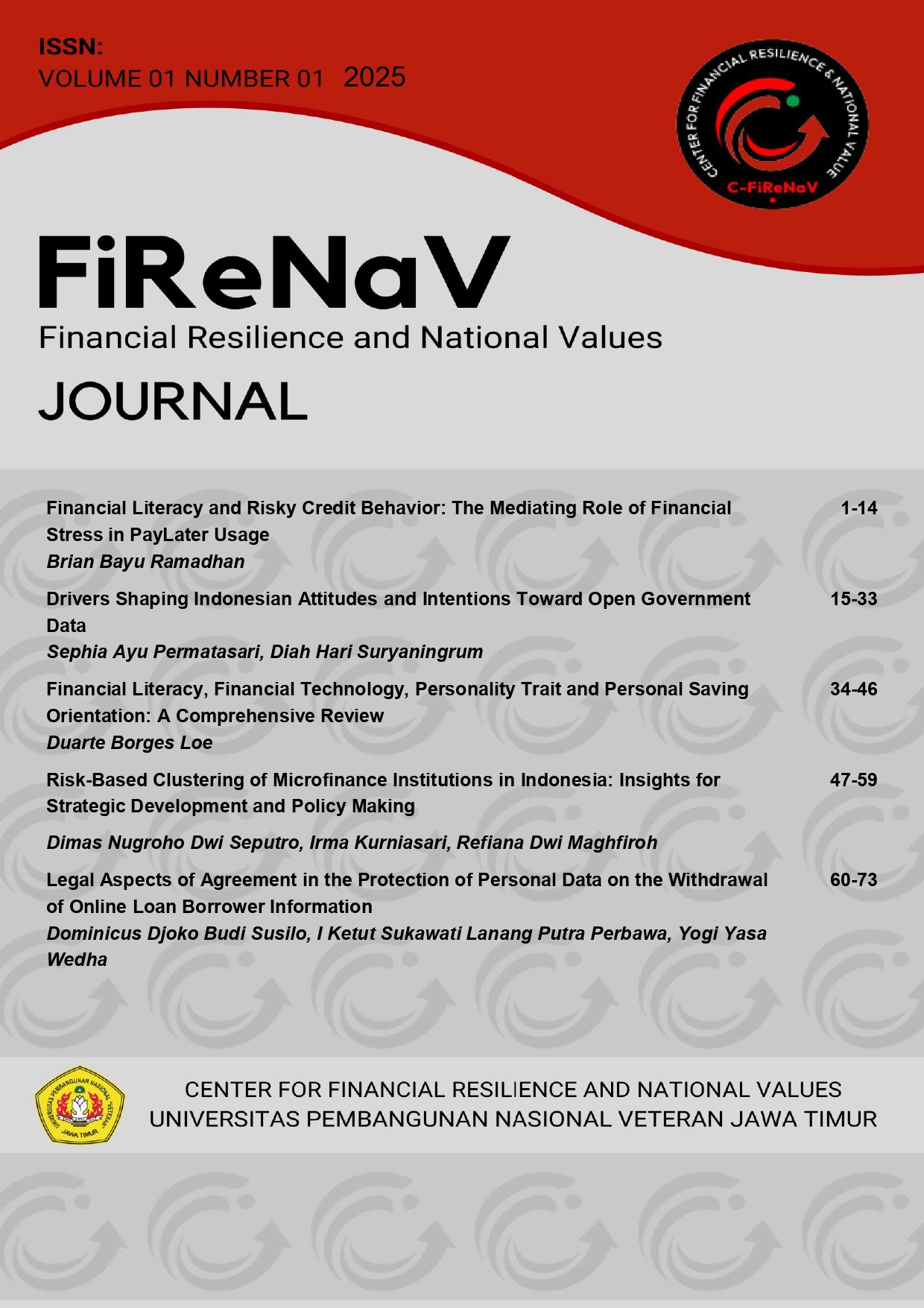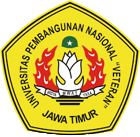Risk-Based Clustering of Microfinance Institutions in Indonesia: Insights for Strategic Development and Policy Making
Keywords:
Microfinance Institution, Cluster Analysis, Risk Analysis, Financial ProfilesAbstract
Purpose: In Indonesia, Microfinance Institutions (MFIs) have gained significant attention as a vital component of economic development. This research is expected to contribute to the strategic development of MFIs as key drivers of economic empowerment and poverty reduction in Indonesia, ensuring their continued relevance and impact in a rapidly changing financial ecosystem through cluster analysis. By clustering provinces according to MFI financial profiles, policy interventions can be more targeted and effective.
Method: This research is quantitative research with secondary data sources from Otoritas Jasa Kuangan (OJK) website. The population in this study are Micro Finance Institutions (MFI) in Indonesia with a total of 23 samples and 9 variables. Data analysis technique using Cluster Analysis.
Findings: Based on the cluster analysis, three clusters of Microfinance Institution (MFI) entities were identified, where: Cluster 1 (High-Risk MFIs): Small-scale MFIs with limited financial activity and higher vulnerability to liquidity issues and defaults. Cluster 2 (Moderate-Risk MFIs): Medium-sized, growing MFIs with balanced financials and potential for further stability through increased customer engagement. Cluster 3 (Low-Risk MFIs): Large, well-established MFIs with strong financials, high deposits, and effective risk management practices
Novelty: This study highlights the integration of fintech solutions by MFIs to improve customer experience, operational efficiency, and financial inclusion. This aspect underscores the transformative impact of technology on traditional financial services. It stands out by combining cluster analysis with a focus on fintech integration and government policy impact, providing a comprehensive and targeted approach to enhancing the strategic development and resilience of MFIs in Indonesia.
References
Adusei, M. & Sarpong‐Danquah, B. (2021). Institutional quality and the capital structure of microfinance institutions: the moderating role of board gender diversity. Journal of Institutional Economics, 17(4), 641-661. https://doi.org/10.1017/s1744137421000023
Annannab, H., Bakar, A., & Khan, S. (2022). Operational risk management and performance of cooperative microfinance in Thailand. International Journal of Social Sciences and Economic Review, 17-24. https://doi.org/10.36923/ijsser.v4i1.148
Artika, D. & Shara, Y. (2021). Analisis peran financial technology dalam meningkatkan keuangan inklusif pada umkm kota medan. Indonesian Journal of Business Analytics, 1(2), 237-248. https://doi.org/10.54259/ijba.v1i2.78
Barguellil, A. & Bettayeb, L. (2020). The impact of microfinance on economic development: the case of Tunisia. International Journal of Economics and Finance, 12(4), 43. https://doi.org/10.5539/ijef.v12n4p43
Bharti, N. & Malik, S. (2021). Financial inclusion and the performance of microfinance institutions: does social performance affect the efficiency of microfinance institutions? Social Responsibility Journal, 18(4), 858-874. https://doi.org/10.1108/srj-03-2020-0100
Detthamrong, U., Nguyen, L., & Chansanam, W. (2023). Leadership and group management: key success factors for microfinance institutions in Chaiyaphum province, Thailand. Sustainability, 15(14), 11192. https://doi.org/10.3390/su151411192
Dillon, W.R. & Goldstein, M. (1987). Goldstein: Multivariat Analysis: Methods and Applications. Biom. J. 1987. 29(6):755-756. http://dx.doi.org/10.1002/bimj.4710290617
Duho, K., Duho, D., & Forson, J. (2021). Impact of income diversification strategy on credit risk and market risk among microfinance institutions. Journal of Economic and Administrative Sciences, 39(2), 523-546. https://doi.org/10.1108/jeas-09-2020-0166
Fadikpe, A., Danquah, R., Aidoo, M., Chomen, D., Yankey, R., & Dong-mei, X. (2022). Linkages between social and financial performance: evidence from Sub-Saharan Africa microfinance institutions. Plos One, 17(3), e0261326. https://doi.org/10.1371/journal.pone.0261326
Ghising, T. (2022). Social performance management and sustainability of microfinance institutions. International Research Journal of MMC, 3(4), 17-20. https://doi.org/10.3126/irjmmc.v3i4.48858
Gunawan, M. & Muzayanah, I. (2023). The role of access to agribusiness microfinance institutions (lkm-a) on poverty reduction: case study in Kuningan district. Jurnal Bina Praja, 15(2), 357-372. https://doi.org/10.21787/jbp.15.2023.357-372
Gupta, A., Gupta, S., & Sapra, R. (2023). Dampak risiko keuangan terhadap kinerja keuangan lembaga keuangan mikro: tinjauan pustaka. Sacheta, 2(2), 67-72. https://doi.org/10.55955/220007
Hemelia & Sumargo, B. (2019). Pengklasifikasian Pengguna Internet Lingkungan Pedesaan Menurut Jenjang Pendidikan di Indonesia Menggunakan Metode Cluster Average Linkage. Jurnal Statistika dan Aplikasinya. 3. 1.
Holle, M. & Manilet, A. (2023). Indeks inklusi keuangan indonesia (analisis kontribusi sektor usaha lembaga keuangan mikro). Investi Jurnal Investasi Islam, 4(2), 550-569. https://doi.org/10.32806/ivi.v4i2.139
Haumahu, G., & Yonlib W. A. N. (2020). Penerapan Analisis Klaster Hierarki untuk Pengelompokkan Kabupaten/kota di Provinsi Maluku Berdasarkan Konsumsi Kalori Penduduk." Variance, vol. 2, no. 2, 2020, pp. 75-79, https://doi:10.30598/variancevol2iss2page75-79.
Illangakoon, A., Azam, S., & Jaharadak, A. (2021). Impact of risk management towards sustainability of microfinance industry in Sri Lanka: a case study. International Journal of Social Sciences and Economic Review, 01-07. https://doi.org/10.36923/ijsser.v3i4.117
Johnson, S.C. (1967) Hierarchical Clustering Schemes. Psychometrika, 32, 241-254. http://dx.doi.org/10.1007/BF02289588
Kadima, A. (2023). Manajemen risiko kredit terhadap kinerja keuangan Lembaga keuangan mikro terpilih. Jurnal Penelitian Empiris Afrika, 4(2), 778-784. https://doi.org/10.51867/ajernet.4.2.79
Lwesya, F. & Mwakalobo, A. (2023). Frontiers in microfinance research for small and medium enterprises (SMEs) and microfinance institutions (mfis): a bibliometric analysis. Future Business Journal, 9(1). https://doi.org/10.1186/s43093-023-00195-3
Maghfiroh, A., Muna, N., Arifin, M., & Farida, N. (2021). Peran bwm al-fithrah wava mandiri surabaya terhadap umkm (nasabah BWM) yang usahanya terdampak pandemi covid 19: fenomenologi study. JPSDA Jurnal Perbankan Syariah Darussalam, 1(2), 122-137. https://doi.org/10.30739/jpsda.v1i2.994
Marino, W. & Gunawan, G. (2021). Upaya pengentasan kemiskinan melalui layanan lembaga keuangan mikro dan program pemberdayaan perempuan di kecamatan rajapolah Kabupaten Tasikmalaya. Jurnal Inspirasi Bisnis dan Manajemen, 4(2), 121. https://doi.org/10.33603/jibm.v4i2.4222
Memon, A., Akram, W., Abbas, G., Chandio, A., Adeel, S., & Yasmin, I. (2021). Keberlanjutan keuangan lembaga keuangan mikro dan faktor makroekonomi: kasus asia selatan. Jurnal Ekonomi Makro dan Keuangan Publik Asia Selatan, 11(1), 116-142. https://doi.org/10.1177/22779787211007970
Mohibullah, M. Hossain, Z.M. & Hasan, M. (2015). Comparison of Euclidean distance function and Manhattan distance function using k-mediods. International Journal of Computer Science and Information Security. 13. 10.
Mwakujonga, J. and Komba, C. (2024). Influence of credit risk management practices on loan performance: a case of selected microfinance institutions in Tanzania. JPDS, 15(2), 26-35. https://doi.org/10.4314/jpds.v15i2.3
Nafisah, Q., & Chandra, N. (2017). Analisis Cluster Average Linkage Berdasarkan Faktor-Faktor Kemiskinan di Provinsi Jawa Timur. Zeta - Math Journal, 3(2), 31-36. https://doi.org/10.31102/zeta.2017.3.2.31-36
Nishom, M. (2019). Perbandingan Akurasi Euclidean Distance, Minkowski Distance, dan Manhattan Distance pada Algoritma K-Means Clustering Berbasis Chi-Square. Jurnal Informatika Politeknik Harapan Bersama, vol. 4, no. 1, 30 Jan. 2019, pp. 20-24, https://doi:10.30591/jpit.v4i1.1253.
Purwanto, P. (2020). Agency cost of credit on microfinance institutions of cooperative and rural bank type. International Journal of Economics Business and Accounting Research (Ijebar), 4(03). https://doi.org/10.29040/ijebar.v4i03.1252
Riski, M. & Shauqi, S. (2023). Analisis pengaruh lembaga keuangan mikro syariah dan lembaga pembiayaan syariah terhadap pertumbuhan ekonomi indonesia tahun 2015-2021. Ihtiyath Jurnal Manajemen Keuangan Syariah, 7(1), 51-65. https://doi.org/10.32505/ihtiyath.v7i1.5424
Romadoni, A. & Herianingrum, S. (2020). Fungsi lembaga keuangan mikro syariah dalam mendorong keuangan inklusif dan sektor riil (BMT NU Jawa Timur di Sumenep). Jurnal Ekonomi Syariah Teori dan Terapan, 7(5), 814. https://doi.org/10.20473/vol7iss20205pp814-825
Saraçli, S., Doğan, N. & Doğan, İ. (2013). Comparison of hierarchical cluster analysis methods by cophenetic correlation. J Inequal Appl 2013, 203 (2013). https://doi.org/10.1186/1029-242X-2013-203
Sinwar, Deepak & Kaushik, Rahul. (2014). Study of Euclidean and Manhattan Distance Metrics using Simple K-Means Clustering. 2.
Suaidah, S. & Arjun, D. (2023). Urgensi dan peran lembaga keuangan mikro dalam pengentasan kemiskinan dan pengembangan ekonomi umat. Reinforce Journal of Sharia Management, 2(1), 75-83. https://doi.org/10.21274/reinforce.v2i1.7416
Uddin, M. (2020). Role of islamic microfinance institutions for sustainable development goals in bangladesh. Journal of International Business and Management, 1-12. https://doi.org/10.37227/jibm-2020-64
Wahab, A. & Mahdiya, I. (2023). Peran lembaga keuangan syariah terhadap pertumbuhan UMKM dalam revitalisasi ekonomi pembangunan di indonesia. Islamadina Jurnal Pemikiran Islam, 24(1), 109. https://doi.org/10.30595/islamadina.v24i1.11713
Winarto, W. (2020). Peran fintech dalam usaha mikro kecil dan menengah (umkm). Jesya (Jurnal Ekonomi & Ekonomi Syariah), 3(1), 61-73. https://doi.org/10.36778/jesya.v3i1.132
Yaqin, A. (2021). Fungsi sosial baitul maal wa tamwil (bmt) pasca uu no 1 tahun 2013 tentang lembaga keuangan mikro. Mabsya Jurnal Manajemen Bisnis Syariah, 3(2), 146-163. https://doi.org/10.24090/mabsya.v3i2.5597






